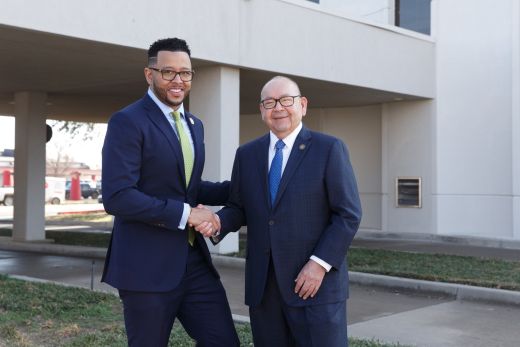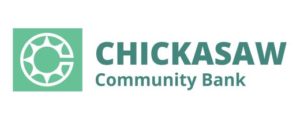
- Details
- By Chickasaw Nation Media
OKLAHOMA CITY, Okla. — Bank2, wholly-owned by the Chickasaw Nation, has helped small businesses, homeowners and community members build better lives for almost two decades. Now, Bank2 is changing its name to Chickasaw Community Bank to better reflect Chickasaw values and heritage.
Chickasaw Nation Governor Bill Anoatubby led a Jan. 14 ceremony celebrating the new name.
“In its name and in its vision, Chickasaw Community Bank pays tribute to the culture and history of Chickasaw entrepreneurship,” said Gov. Anoatubby. “From extensive trade routes along the Mississippi River in our Homeland to new businesses in Indian Territory, commerce has long been seen as a way to improve the quality of life of our people.
“Today, our businesses remain an integral part of our mission to enhance the quality of life of the Chickasaw people. We also work to ensure business diversification and economic development include a focus on local communities, because we believe a rising tide should lift all ships.”
 Chickasaw Nation Governor Bill Anoatubby, right, and Chickasaw
Chickasaw Nation Governor Bill Anoatubby, right, and Chickasaw
Community Bank CEO T.W. Shannon at the unveiling ceremony.
Bank CEO T.W. Shannon said the new brand, Chickasaw Community Bank, better reflects the bank’s purpose, “Building Better Lives for Everyone,” as well as its mission and community partnership initiatives.
“The Chickasaw Nation has always been about improving the quality of life of our community,” said Mr. Shannon. “As a community bank headquartered in Oklahoma City, this name change will reflect those values and the Bank’s commitment to our heritage and partnership initiatives.
 “At Chickasaw Community Bank we are committed to building better lives for everyone, starting with our employees and customers. As a state-chartered community bank we offer banking products and service for all Oklahomans including commercial lending and home mortgages. We are the leader in the state for the HUD 184 Native American mortgages.”
“At Chickasaw Community Bank we are committed to building better lives for everyone, starting with our employees and customers. As a state-chartered community bank we offer banking products and service for all Oklahomans including commercial lending and home mortgages. We are the leader in the state for the HUD 184 Native American mortgages.”
Opened in 2002, the bank’s assets have increased to more than $200 million since initial capital investment of $9 million. While serving the Native American community is a significant part of the mission, the positive impact extends throughout the community, the state and across the United States.
“The blessing of being a community banker is that we really do help people’s dreams come true,” said Mr. Shannon. “Whether we are helping Oklahomans start a business, or helping someone buy their first home, Chickasaw Community Bank is on the ground floor of the American dream.
“The impeccable reputation of our shareholder the Chickasaw Nation, and our leader Governor Anoatubby, are above reproach and it is important that our customers and community know that our bank is an extension of those values and character.”
While Bank2 has been in operation less than two decades, the Chickasaw Nation involvement in the banking business began more than a century ago.
The Bank of the Chickasaw Nation was established in Indian Territory in the early 1900s in the historic Chickasaw Nation capitol city, Tishomingo.
Built on Main Street as a depository for all Chickasaw Nation funds, former Chickasaw Nation Governor Robert Maxwell Harris served as the first bank president. Banking operations began with $25,000 in capital, which doubled in a few days. The two-story Romanesque granite structure was proclaimed to be “the handsomest, most complete, and the most secure bank in the two (Choctaw and Chickasaw) territories.”
Governor Anoatubby said the Chickasaw Community Bank is an important part of the tribe’s diverse portfolio of more than 100 business holdings, which also include manufacturing, energy, health care, media, technology, hospitality, retail and tourism. Currently, the Chickasaw Nation supports more than 22,000 jobs and $1.2 billion in wages and benefits as part of a $3.7 billion annual economic contribution to the Oklahoma economy.
Business revenues provide the majority of funding for more than 200 programs and services, such as health care, housing and education.
More Stories Like This
American Basketball Association Announces Native ABA InitiativeFour Winds South Bend Upgrades to Class III Gaming Casino
Native News Online Wins Two Awards from Native American Journalists Association
Wahlberg Brothers Are a Big Hit at Indian Gaming Tradeshow and Convention in Las Vegas
Native Gro Offers Tribes a ‘One-Stop Shop’ for Entering the Cannabis Industry
Help us defend tribal sovereignty.
At Native News Online, our mission is rooted in telling the stories that strengthen sovereignty and uplift Indigenous voices — not just at year’s end, but every single day.
Because of your generosity last year, we were able to keep our reporters on the ground in tribal communities, at national gatherings and in the halls of Congress — covering the issues that matter most to Indian Country: sovereignty, culture, education, health and economic opportunity.
That support sustained us through a tough year in 2025. Now, as we look to the year ahead, we need your help right now to ensure warrior journalism remains strong — reporting that defends tribal sovereignty, amplifies Native truth, and holds power accountable.
 The stakes couldn't be higher. Your support keeps Native voices heard, Native stories told and Native sovereignty defended.
The stakes couldn't be higher. Your support keeps Native voices heard, Native stories told and Native sovereignty defended.
Stand with Warrior Journalism today.
Levi Rickert (Potawatomi), Editor & Publisher
